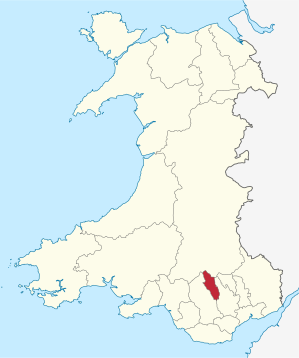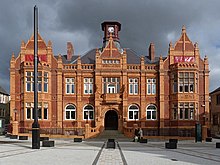Merthyr Tydfil
| Merthyr Tydfil County Borough | |
|---|---|
| Administrative headquarters | Merthyr Tydfil |
| surface | 111 km² |
| Residents | 58,802 (2011) |
| Welsh speakers | 17.7% |
| ISO 3166-2 | GB-MTY |
| ONS code | 00PH |
| Website | www.merthyr.gov.uk |
Merthyr Tydfil ( Welsh : Merthyr Tudful ) is a town and principal area in South Wales . The city is named after the martyr Tydfil , the daughter of the Welsh tribal leader Brychan Brycheiniog , king of Brycheiniog , who was killed in AD 480 . Tydfil was killed and later canonized by pagan Anglo-Saxons because of her Christian faith.
history
Until the mid-18th century, Merthyr Tydfil was a quiet village in a graceful valley. This is how Daniel Defoe , who traveled through in 1723, described it . Its inhabitants lived mainly from sheep breeding and from selling wool.
During the Industrial Revolution , Merthyr Tydfil experienced strong expansion because of the nearby iron ore , coal and limestone deposits, as well as its abundance of water. The small town of Merthyr grew explosively in the course of the mining of natural raw material deposits and the associated settlement of steelworks (from a good 700 inhabitants to around 80,000 in the 1920s) and subsequently developed into the iron and steel capital of the world .
Important companies of the time were:
- Dowlais Iron Company , originally founded in 1759 by Thomas Lewis Llanishen under the name Merthir Ofens . The plant was closed in the 1930s. See also under: GKN plc.
- Plymouth Ironworks , founded in 1763 by John Guest and Isaac Wilkinson, taken over by Anthony Bacon in 1765. The factory was closed in 1882.
- Cyfarthfa Ironworks , founded in 1765 by Anthony Bacon, taken over by Richard Crawshay in 1794. The ironworks closed in April 1874 and reopened as a steelworks in 1882, which existed until 1910. As a result of the First World War, the plant was used from 1915 to 1919 before it was finally closed.
- Penydarren Ironworks , founded in 1784 by Samuel Homfray, financially supported by George Forman from London. The factory was closed in 1859.
On April 6, 1901, the Merthyr Electric Traction & Lighting Company, a subsidiary of the British Electric Traction Company, opened a 16-vehicle tram service from Cefn Coed to the Bush Hotel Dowlais and from Pontmorlais Circus to Graham Street. The tram was closed in 1939.
In February 1804, the world's first steam-powered locomotive, designed by Richard Trevithick , ran at Merthyr Tydfil's Penydarren ironworks.
The recession of 1829 had turned the city into a debt crisis. In early June 1831, a riot broke out in Merthyr Tydfil, a stronghold of the Radicals at that time , when a local entrepreneur tried to pay part of the salary in the form of goods to the owners of the coal mines and ironworks provided. In the course of the events, the approximately 10,000 insurgents took control of almost the entire city on June 1, destroyed the local court of justice, looted confiscated property and besieged the hotel in which the city administration had holed up. On June 3, the intervention of the city administration led to the intervention of the military, which brought the city under its control by June 8 and shot around 24 residents.
In 1841 the Taff Vale Railway was completed, a rail link from Dowlais to Cardiff.
The decline of the iron and coal industry began after the First World War and was not stopped by a brief flare-up in the wake of the increased demand for armaments during the Second World War .
In April 1946, Teddington Aircraft Controls Limited (a subsidiary of the British Thermostat Co. Limited Group) opened a plant in Cefn Coed, which u. a. Manufactured de-icing systems for passenger aircraft and helicopters. The subsidiary was sold in 1971. Thorn Electrical Industries Ltd., founded in 1947. became bankrupt in 1992 and was dissolved.
Population development
- 1881: 48.861
- 1891: 58.080
- 1901: 69.228
- 1921: 80.990
- 1931: 71.108
- 1939: 61.852
- 1951: 61.142
- 1961: 59.039
- 1991: 59.317
- 2001: 55.981
- 2009: 55,600
economy
In 1979, Sekisui Foam Products (now Sekisui Alveo and a subsidiary of Sekisui Chemical) opened a plant in the Pentrebach district.
In 1996, the South Korean industrial truck manufacturer Halla Ltd. a production facility in Merthyr Tydfil, which was taken over by Linde Material Handling in 2000 . Container forklifts, diesel heavy-duty forklifts and cross-stackers are produced on the 240,000 square meter site. Production stopped in 2013.
Sports
- Merthyr Tydfil FC , football club 1945–2010
Attractions

- Cyfarthfa Castle in Merthyr Tydfil, castle of the Crawshay family who founded the Cyfartha factory, is now a school and museum
- Victorian viaduct in Cefn Coed in the north of the city
- Viaduct near Pontsarn in front of Vaynor
- Viaduct over Quaker's Yard
- Narrow gauge train Brecon Beacons Mountain Railway (3 km) from Pant to Pontsticill Lake, the city's water reservoir
- Guest Memorial Library , built in 1863 at the instigation of Lady Charlotte Guest , who translated the well-known Welsh medieval work Mabinogion into English. Today the library is used as a leisure center.
Trivia
The cannon balls that sank Napoleon's fleet on the Nile in 1799 and were used in Trafalgar in 1805 were produced in Merthyr Tydfil.
In an article published in 1855, “Die Gartenlaube” describes the conditions in the city in gloomy colors.
sons and daughters of the town
- John Hughes (1815-1889), entrepreneur
- Joseph Parry (1841–1903), musician and composer
- Richard Bell (1859–1930), trade unionist, politician (Labor Party) and member of the House of Commons
- Jack Jones (1884-1970), writer
- Laura Ashley (1925–1985), designer
- Johnny Owen (1956-1980), bantamweight boxer
- Mark Pembridge (born 1970), football player
- Julien Macdonald (* 1971), fashion designer
- Rhydian Richards (* 1975), snooker player
- Ian David Karslake Watkins (born 1977), singer in the band Lostprophets
- Gavin Williams (born 1980), football player
- Chris Type (* 1981), skeleton rider
- Sean Smith (born 1983), singer in the band The Blackout
Personalities
- Keir Hardie (1856-1915), Scottish politician who represented Merthyr Tydfil in Parliament from 1900 to 1915 for the Labor Party and was the first Labor MP in the House of Commons.
Individual evidence
- ↑ Official population figures 2011 ( MS Excel ; 291 kB)
- ↑ Stewart Williams: Glamorgan historian . Vol. 8. D. Brown, Cowbridge and Barry 1972, p. 171.
- ^ John Davies: A History of Wales , London: Penguin, 1994, pp. 366-368
- ↑ Visit to an English coal and iron town
Coordinates: 51 ° 45 ′ N , 3 ° 23 ′ W


